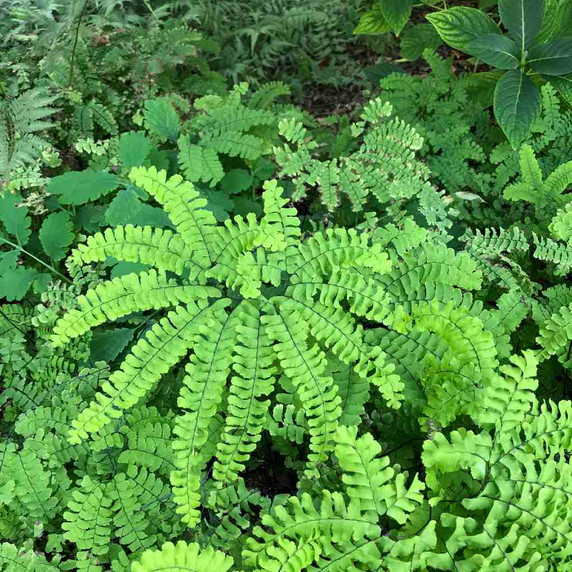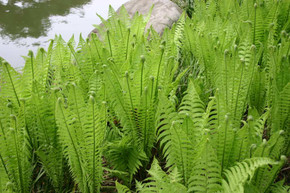
Adiantum pedatum - NORTHERN MAIDENHAIR FERN
One of the most popular, unique looking native ferns. Delicate horizontal fronds arranged in circular pattern, dark up to black stems.
Usually grow to about 1-1.5' of height and 1-2' of width (in ideal conditions up to 3' tall). Deciduous fern that dies back every fall. Quite slowly creeps with underground rhizomes to form smaller colonies.
Half shade to shade, adaptable to many soil types, but prefers medium moist soil enriched with some organic matter (leaf compost, smaller amount of composted bark or mulch).
Optimally soil should be moist, but not wet. Adapts to loam, sandy soil, clay, chalky soils.
Maidenfern doesn't tolerate heavier drought.
Naturally occurs on north facing slopes, cooler spots in deciduous woodlands, close to seeps or natural spring, usually on rich and slightly acidic soils. Native to the whole eastern and partially central part of North American continent (but also native to Asia), see the USDA distribution map.
Deer and rabbit resistant. Black walnut tolerant. Hardy in zones 3 to 8.
Provides shelter for toads, lizards and other small creatures. Indigenous people made tea out of the leaves to treat respiratory troubles, stems were used for baskets.
Best for shaded flower beds, woodland gardens, native plant gardens, shaded parts of rain gardens, shaded rock garden.
Looks the best, if combined with larger-leaved perennials like Asarum, Astilboides tabularis, Caladium and Coleus (used as annuals), Bergenia, Brunnera, bigger-leaved Epimedium, Heuchera, Heucherella, Hosta, Ligularia, Rodgersia, Podophyllum, Polygonatum, Candelabra Primula, Tiarella,Trillium, Uvularia and also fine or rough-textured grasses like Carex or Hakonechloa.
Good combos are also with smaller shrubs like Hydrangea.
Less successful combinations are with plants with divided or compound leaves of Astilbe, Geranium maculatum, Geranium nodosum, Helleborus or Syneilesis or too short plants like Phlox divaricata or Iris cristata.
Pot size : square 3.5" x 4" deep perennial pot
Picture copyright : US Perennials nursery

Adiantum pedatum - NORTHERN MAIDENHAIR FERN
One of the most popular, unique looking native ferns. Delicate horizontal fronds arranged in circular pattern, dark up to black stems.
Usually grow to about 1-1.5' of height and 1-2' of width (in ideal conditions up to 3' tall). Deciduous fern that dies back every fall. Quite slowly creeps with underground rhizomes to form smaller colonies.
Half shade to shade, adaptable to many soil types, but prefers medium moist soil enriched with some organic matter (leaf compost, smaller amount of composted bark or mulch).
Optimally soil should be moist, but not wet. Adapts to loam, sandy soil, clay, chalky soils.
Maidenfern doesn't tolerate heavier drought.
Naturally occurs on north facing slopes, cooler spots in deciduous woodlands, close to seeps or natural spring, usually on rich and slightly acidic soils. Native to the whole eastern and partially central part of North American continent (but also native to Asia), see the USDA distribution map.
Deer and rabbit resistant. Black walnut tolerant. Hardy in zones 3 to 8.
Provides shelter for toads, lizards and other small creatures. Indigenous people made tea out of the leaves to treat respiratory troubles, stems were used for baskets.
Best for shaded flower beds, woodland gardens, native plant gardens, shaded parts of rain gardens, shaded rock garden.
Looks the best, if combined with larger-leaved perennials like Asarum, Astilboides tabularis, Caladium and Coleus (used as annuals), Bergenia, Brunnera, bigger-leaved Epimedium, Heuchera, Heucherella, Hosta, Ligularia, Rodgersia, Podophyllum, Polygonatum, Candelabra Primula, Tiarella,Trillium, Uvularia and also fine or rough-textured grasses like Carex or Hakonechloa.
Good combos are also with smaller shrubs like Hydrangea.
Less successful combinations are with plants with divided or compound leaves of Astilbe, Geranium maculatum, Geranium nodosum, Helleborus or Syneilesis or too short plants like Phlox divaricata or Iris cristata.
Pot size : square 3.5" x 4" deep perennial pot
Picture copyright : US Perennials nursery









